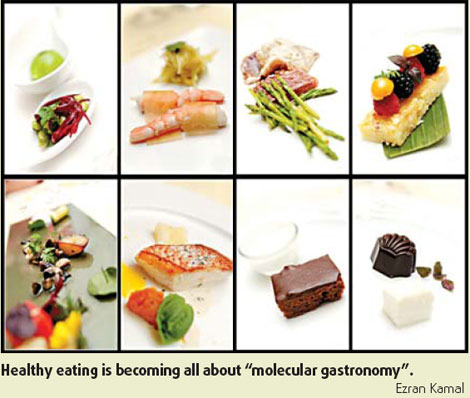
An indulgent trip to the Blu Lobster in Beijing diverted my attention from nutritional science to that of "Molecular Gastronomy", the scientific study of the physical and chemical things that occur during cooking.
In recent years, this term has been applied more widely to the innovations of a handful of chefs who whip up unlikely dishes that challenge and delight diners with their bizarre taste, texture and flavor combinations.
The beginnings of this movement can be traced back to the early 1980s when American scientist Harold McGee published his book On Food and Cooking: The Science and Lore of the Kitchen. This book sought to explain what happens at a molecular level as you boil, roast, sear and grate food etc. It inspired a few key chefs to develop a more scientific approach to cooking.
One of these was the experimental British chef Heston Blumenthal who owns The Fat Duck, a three star Michelin restaurant in Berkshire, UK. This is the man responsible for putting "snail porridge" and "bacon-and-egg ice cream" on the menu and who reportedly considers not only taste but touch, sound, sight, smell and proprioception, (the sense of "ourselves") in his quest to create perfect food.
Another devotee is Ferran Adria, often touted as the best chef in the world and the mastermind behind El Bulli on the Costa Brava in Spain (recently voted the "Best Restaurant in the World" for the fourth time by Restaurant Magazine). He is best known as the creator of "culinary foam"; ingredients such as avocado, coffee or mushroom are mixed with a gelling agent and aerated with nitrous oxide to produce light, intensely flavored mousses.
Adria has taken things a step further and actually has a laboratory located about 250 km away from his restaurant in Barcelona in which his menus are researched. The restaurant itself closes for six months each year whilst Adria trots the globe in search of culinary inspiration.
"Molecular Gastronomy" seeks to encourage experimentation with unusual cuts of meat - well, unusual perhaps to Western kitchen dwellers, but not to the Chinese.
One of the many good things about China is that it is extremely easy to get your hands on pig's trotters and the like, so why not splash out on Blumenthal's recently released book, The Big Fat Duck Cooking Book for a meager $250 and recoup your investment by wowing your friends and family with Pork cheek culinary foam (I jest!) or some such dish.
As mentioned, in Beijing, your best bet for such a restaurant dining experience is a visit to the Blu Lobster. This restaurant was opened by the pioneering chef Brian McKenna last year. Although he has recently moved on to open his own premises elsewhere in Beijing, the Blu Lobster continues to live up to its previous reputation. It serves up highly creative dishes such as an "amuse bouche" of fresh oyster served with star anise sorbet dotted with popping candy that gently explodes in your mouth, or chunks of lobsters and caviar topped off with a foamed lobster bisque that is delivered from a siphon at the table.
To my mind, all of this science does have some bearing on health eating. I'm not suggesting we go to extraordinary lengths to recreate the bizarre concoctions of Blumenthal and his buddies but I'm sure you'll agree that eating should be pleasurable and food should be savored.
If one takes the time to understand food, to cook meals properly, to taste and enjoy each mouthful then one is less likely to fall into habits of wolfing down tasteless mounds of calorie-dense and nutrient-poor stodge in the name of fuel.
This nutrition-related column is written by Nina Lenton, a qualified dietitian living and working in Beijing. Contact her at nina_lenton@hotmail.com.
(China Daily October 15, 2008)